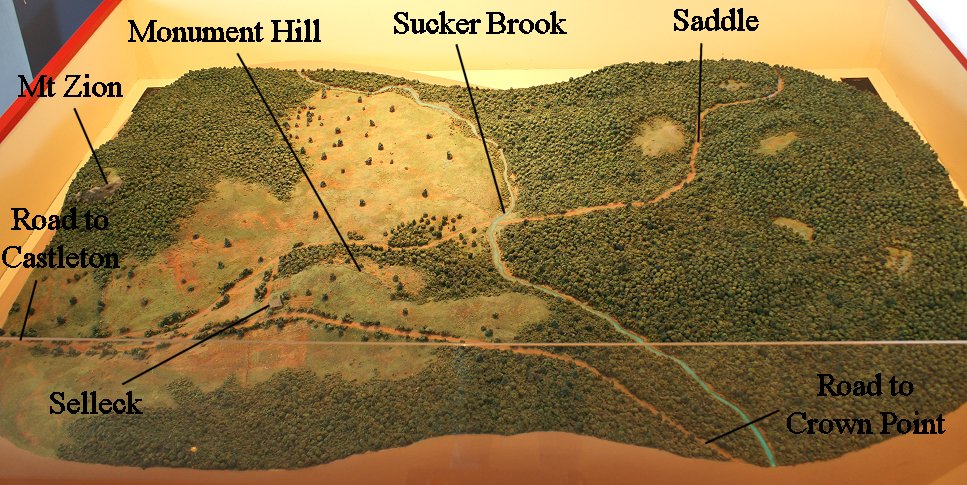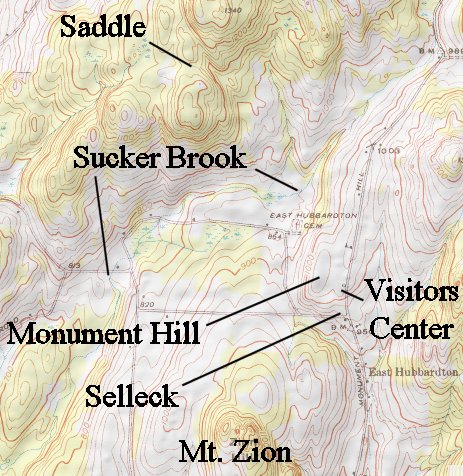Hubbardton
July 7, 1777
With no reasonable hope for a successful defense of Ticonderoga, Gen. St Clair and his army crossed Lake Champlain to Mount
Independence on the
night of July 6th to begin a retreat southeastward along a crude military
road to Castleton. St. Clair then planned to march his army southwest to
Skenesborough at the south end of Lake Champlain to link up with Col
Pierce Long and boats carrying men, weapons, and supplies from
Ticonderoga. The rear guard of around 1,200 under Col Seth Warner
camped the night at Hubbardton in the Hampshire Grants - now Vermont - but of this total around 300 were stragglers.
A British pursuit force of 850 men under Brigadier Simon Fraser camped a few
miles short of the Americans, and a reinforcing column of 1,100 men under the
Brunswick General Riedesel camped a few miles back from Fraser.
Early on the morning on July 7th, between 3 and 4am, Fraser got his men
on the march. The British clashed with an American picket in the
saddle between two peaks then deployed near Sucker Brook. Ahead
of them was a mass of American stragglers under Col Hale.



Monument Hill
As Fraser clashed with the mass of
stragglers along Sucker Brook, the majority of the American
force was in column of march along the Crown Point - Castleton
road ready to continue the march. Hearing the action, Warner
moved his men from the road and into line on what came to be known as
Monument Hill.

While Fraser and his light infantry
attacked Monument Hill, the 24th Regiment attacked near the Selleck
House and Acland's Grenadiers and a detachment of light infantry under
Lindsay swung to the right - skirting the Mt. Zion ridge. Acland
clashed with Warner's Regiment along the road in the area on the
left side of the panorama, and Lindsay overlapped the American flank.
The Americans fell back from Monument Hill to behind the Crown
Point / Castleton Road, and Warner fell back too, refusing the flank of
the new position.

The new American line was behind the road, with Warner's Regiment
refusing the flank. Acland attacked Warner while Lindsay's
detachment of light infantry crossed a small stream and overlapped the
American flank.

The American line along the road had been
holding up well, and Fraser's left flank was under pressure. By
this point, Riedesel's Brunswick troops were arriving, having marched
through the Saddle into the lower land below. From there, with
bands blaring so that the force would appear larger, Riedesel's men
advanced around the American right flank, crossing the Crown Point /
Castleton Road somewhere in this area and pivoting right and attacking
the American line behind a log fence along the road on the left side of
the panorama.
With the enemy overlapping both flanks,
the Americans were forced from the field, fleeing across Pittsford
Ridge. The battle had lasted about three hours, but the pursuit
was temporarily halted, with the British and their German allies
staying at Hubbardton until the next day, leaving the main
American army to retire unmolested. Warner and many of the
patriots regrouped at Manchester and menaced the flank of Burgoyne's
advance.
Casualty figures are fuzzy, but
the Americans appear to have lost 371 men, of which 41 were killed and
96 were wounded. The British and Germans lost 70 killed and 148
wounded.
The checked British pursuit allowed St Clair's army to escape
intact and survive to fight another day. Learning of the fall of
Skenesborough, St Clair avoided the area, marching more south than
southeast. Thinking that the Americans might have a naval
presence on Lake George, Burgoyne advanced his army overland from
Skenesborough toward the Hudson River, a longer route that required
construction of a road. This gave the American army a better
opportunity to obstruct the British advance and gave them time to
evacuate a wagon train from Fort George near the south end of Lake
George. The British, meanwhile, would be hampered by inadequate
logistical preparations, but prospects still looked bright.
Back
to Revolutionary War Virtual Battlefield Tours






